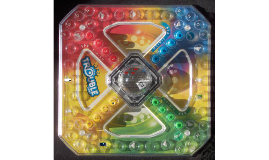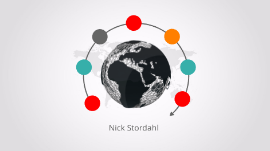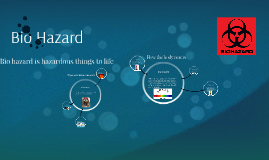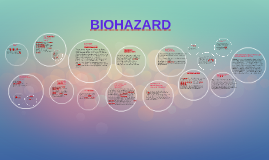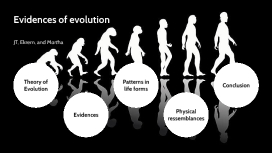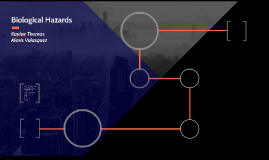Biohazard
Transcript: Bioterrorism agents are a concern to laboratories. These agents are divided into categories A, B, and C. The United States' Centers for Disease Control and Prevention (CDC) categorizes various diseases in levels of biohazard, Level 1 being minimum risk and Level 4 being extreme risk. Laboratories and other facilities are categorized as BSL (Biosafety Level) 1-4 or as P1 through P4 for short (Pathogen or Protection Level). Biohazard Level 3: Bacteria and viruses that can cause severe to fatal disease in humans, but for which vaccines or other treatments exist, such as anthrax, West Nile virus, Venezuelan equine encephalitis, SARS virus, tuberculosis, typhus, Rift Valley fever, HIV, Rocky Mountain spotted fever, yellow fever, and malaria. Among parasites Plasmodium falciparum, which causes Malaria, and Trypanosoma cruzi, which causes trypanosomiasis, also come under this level Category A Pathogens that are rarely seen in the US. These agents have the highest priority; organisms in this category pose a risk to national security because they; • Can be easily disseminated or transmitted from person to person • Result in high mortality rates and have the potential major public health impact • Might cause public panic and social disruption • Require special action for public health preparedness Biological Hazard Safety Submitted By: OSHA requires laboratories to have a personal protective equipment (PPE) program. The components of this regulation include: • A workplace hazard assessment with a written hazard certification • Proper equipment selection • Employee information and training, with written competency certification • Regular reassessment of work hazards Biohazard Level 2: Bacteria and viruses that cause only mild disease to humans, or are difficult to contract via aerosol in a lab setting, such as hepatitis A, B, and C, influenza A, Lyme disease, salmonella, mumps, measles, scrapie, dengue fever. "Routine diagnostic work with clinical specimens can be done safely at Biosafety Level 2, using Biosafety Level 2 practices and procedures. Research work (including co-cultivation, virus replication studies, or manipulations involving concentrated virus) can be done in a BSL-2 (P2) facility, using BSL-3 practices and procedures. It is used in the labeling of biological materials that carry a significant health risk, including viral samples and used hypodermic needles. $1.25 Thursday, March 13, 2014 Avoiding transmission of infectious diseases Medical Technologist Hazel Mae D. Molejon Kimberly Ann D. Aiko Hand washing Vol XCIII, No. 311 Description: Category C These agents have the third-highest priority and includes emerging pathogens that could be engineered for mass dissemination in the future because of: • Availability • Ease of production and dissemination • Potential for high morbidity and mortality rates and major health impact 1. Educate and train all healthcare workers in Standard Precautions and preventing blood-borne infections. 2. Provide proper equipment and supplies (e.g. gloves) 3. Monitor compliance with the protective biosafety principles Category B These agents have the second-highest priority and include pathogens that: • Are moderately easy to disseminate • Result in moderate morbidity rates and low mortality rates • Require specific enhancements of the CDC’s diagnostic capacity and enhanced disease surveillance Biological hazards, also known as biohazards, refer to biological substances that pose a threat to the health of living organisms, primarily that of humans. This can include medical waste or samples of a microorganism, virus or toxin (from a biological source) that can affect human health. It can also include substances harmful to animals. Frequent Handwashing is an important safety precaution. It should be performed after contact with patients and laboratory specimens. • Gloves should be used as an adjunct to, not a substitute for handwashing. • At the very minimum, hands should be washed with soap and water or hand antisepsis with an alcohol-based handrub ( if hands are not visibly soiled) "Until politics are a branch of science we shall do well to regard political and social reforms as experiments rather than short-cu ts to the millennium." ~J.B.S. Haldane Biohazard Level 4: Viruses and bacteria that cause severe to fatal disease in humans, and for which vaccines or other treatments are not available, such as Bolivian and Argentine hemorrhagic fevers, Marburg virus, Ebola virus, hantaviruses, Lassa fever virus, Crimean–Congo hemorrhagic fever, and other hemorrhagic diseases. Variola virus (smallpox) is an agent that is worked with at BSL-4 despite the existence of a vaccine. When dealing with biological hazards at this level the use of a positive pressure personnel suit, with a segregated air supply, is mandatory. The entrance and exit of a Level Four biolab will contain multiple showers, a vacuum room, an ultraviolet light room, autonomous detection system, and other safety






